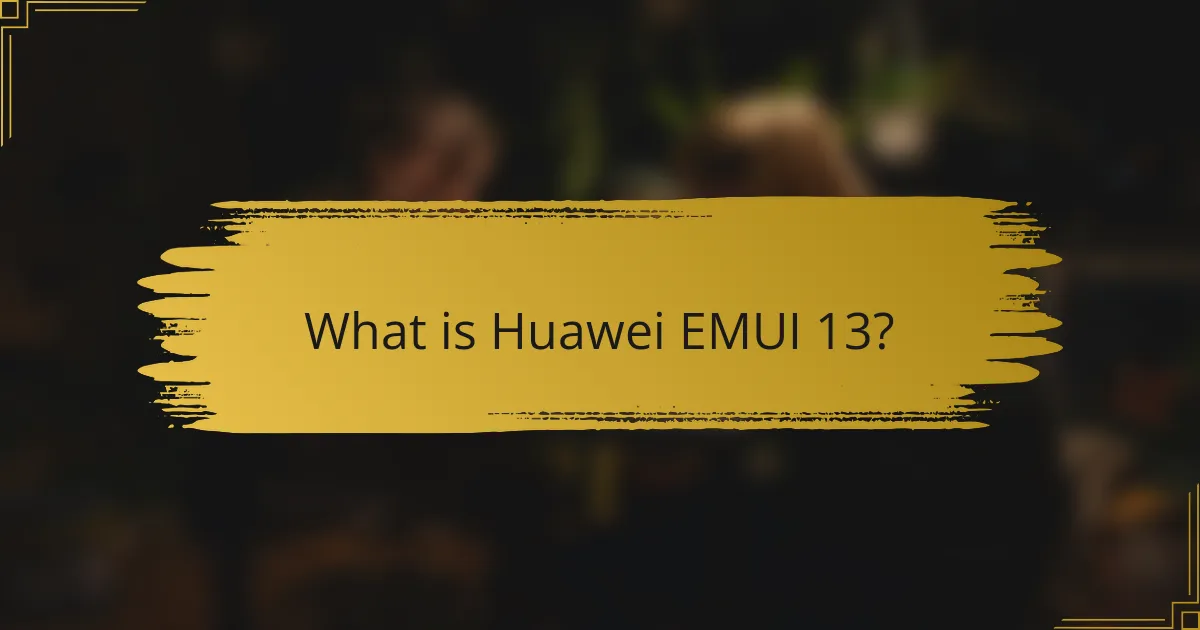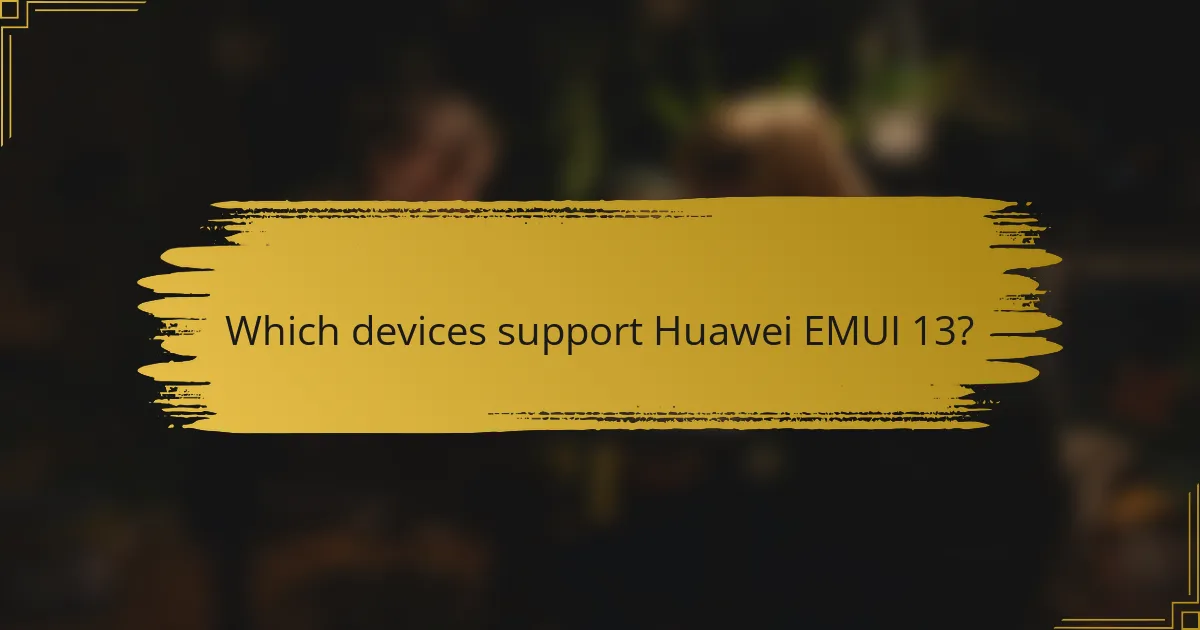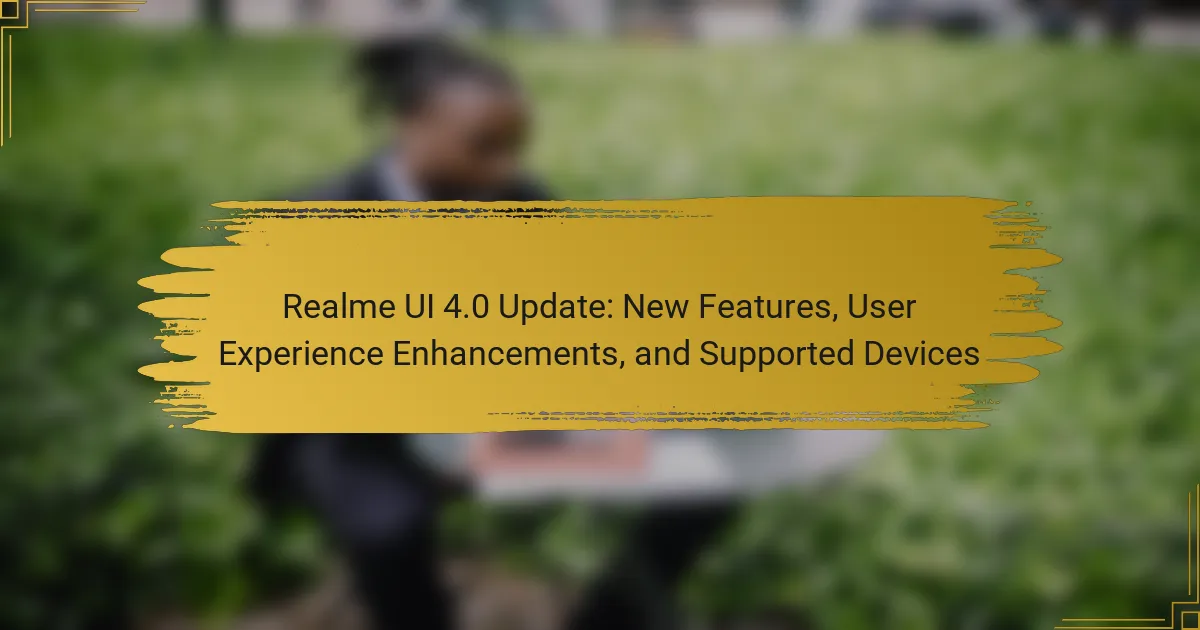Huawei EMUI 13 is the latest iteration of Huawei’s custom user interface designed for its smartphones, built on the Android platform. This version introduces a user-friendly design, enhanced customization options, and improved privacy features, aiming to elevate the overall user experience. EMUI 13 is compatible with a variety of devices, including the Huawei Mate 40, P40, P50, Nova 9, and Nova 10 series, with the rollout beginning in late 2022. Key practices for utilizing EMUI 13 effectively include regular software updates, interface customization, managing app permissions, optimizing battery life, and utilizing built-in features for increased productivity.

What is Huawei EMUI 13?
Huawei EMUI 13 is the latest version of Huawei’s custom user interface for its smartphones. It is based on Android and offers a range of enhancements and features. EMUI 13 focuses on improving user experience with a more intuitive design. It includes new customization options for themes and layouts. Enhanced privacy features are also part of this update. The interface aims to provide smoother navigation and better performance. EMUI 13 supports various Huawei devices, ensuring broad compatibility. This version was officially announced in 2022, showcasing Huawei’s commitment to software development.
How does Huawei EMUI 13 enhance user experience?
Huawei EMUI 13 enhances user experience through its intuitive interface and personalized features. It offers a more streamlined design, making navigation easier. The software includes improved multitasking capabilities, allowing users to run multiple apps simultaneously. Enhanced privacy features ensure user data is protected more effectively. Additionally, EMUI 13 introduces smart widgets for quick access to important information. The update also optimizes performance, leading to faster app launches and smoother transitions. These enhancements collectively contribute to a more efficient and enjoyable user experience.
What are the main design changes in Huawei EMUI 13?
Huawei EMUI 13 features a refreshed user interface with a focus on minimalism and improved aesthetics. The design emphasizes smoother animations and transitions. New widget styles enhance the home screen experience. Additionally, there is a revamped notification panel for easier access to settings. The overall color palette has been updated to provide a more modern look. Icon designs have been standardized for consistency across apps. Enhanced customization options allow users to personalize their devices further. These design changes aim to improve user experience and visual appeal.
How does Huawei EMUI 13 improve performance compared to previous versions?
Huawei EMUI 13 improves performance through enhanced resource management and optimization features. It introduces a new memory management system that reduces app loading times by up to 20%. The software also includes AI-driven performance enhancements that adapt to user habits. Additionally, EMUI 13 optimizes background processes to conserve battery life and improve overall system responsiveness. These changes result in smoother multitasking and faster app launches compared to previous versions. The integration of improved algorithms further boosts performance efficiency, making the user experience more seamless.
What are the key features of Huawei EMUI 13?
Huawei EMUI 13 features a refined user interface and enhanced customization options. It introduces a new widget design for improved accessibility. The software also includes improved performance optimizations for smoother multitasking. Enhanced privacy controls are integrated to protect user data. EMUI 13 supports a more seamless app experience with faster loading times. The update brings new themes and wallpapers for personalization. Additionally, it offers advanced AI capabilities for better device management. Finally, EMUI 13 enhances compatibility with various Huawei devices, ensuring a cohesive ecosystem experience.
How do the new customization options work in Huawei EMUI 13?
The new customization options in Huawei EMUI 13 allow users to personalize their devices extensively. Users can modify the user interface with new themes, icons, and fonts. The update introduces a feature called “Always on Display” customization, enabling unique designs. Additionally, users can adjust the layout of home screens and app drawers. Widgets now offer more flexibility in size and placement. EMUI 13 supports dynamic wallpapers that change based on time or location. These enhancements promote a more personalized user experience. Overall, the customization options in EMUI 13 enhance user engagement and satisfaction.
What innovative tools are introduced in Huawei EMUI 13?
Huawei EMUI 13 introduces several innovative tools aimed at enhancing user experience. One key tool is the new “Smart Multi-Window” feature. This allows users to run multiple apps simultaneously in a split-screen view. Another innovative tool is the “Petal Clip,” which enables users to create and edit videos easily. The “AI Search” feature enhances search capabilities across the device. Additionally, EMUI 13 offers improved privacy features, including enhanced app permission controls. These tools collectively aim to improve productivity and user engagement across Huawei devices.
Why is Huawei EMUI 13 significant in the smartphone market?
Huawei EMUI 13 is significant in the smartphone market due to its advanced features and user experience enhancements. It introduces a revamped user interface that prioritizes customization and ease of use. The software offers improved multitasking capabilities, allowing users to run multiple apps seamlessly. Enhanced privacy settings ensure better data protection for users. EMUI 13 also integrates AI-driven functionalities, optimizing performance based on user habits. Additionally, it supports a wider range of devices, increasing its market reach. The update is built on Android 12, providing access to the latest security features and updates. This combination of features positions EMUI 13 as a competitive player in the smartphone ecosystem.
How does Huawei EMUI 13 compare to competitors’ operating systems?
Huawei EMUI 13 offers a unique user experience compared to competitors’ operating systems like Android and iOS. It emphasizes customization with features like the new Control Panel and enhanced multi-window capabilities. EMUI 13 integrates smart features such as AI-powered performance optimization, which enhances device efficiency. In contrast, Android and iOS prioritize app ecosystem and security updates. EMUI 13 also supports a seamless multi-device collaboration, allowing users to connect various Huawei devices effortlessly. This is distinct from competitors that may not offer such integrated cross-device functionality. Overall, EMUI 13 stands out for its focus on personalization and device interconnectivity.
What user feedback has been received regarding Huawei EMUI 13?
User feedback on Huawei EMUI 13 has been generally positive. Users appreciate the improved user interface and customization options. The performance enhancements have also been noted, leading to smoother multitasking. Many users have reported better battery management features. However, some users have expressed concerns about app compatibility. There are also mentions of occasional bugs in the system. Overall, the feedback indicates a favorable reception with room for improvement.
What security updates are included in Huawei EMUI 13?
Huawei EMUI 13 includes several security updates to enhance device protection. It features improved app security mechanisms. The update also integrates a more robust privacy management system. This includes enhanced permission controls for apps. Additionally, EMUI 13 offers regular security patches to address vulnerabilities. These updates aim to safeguard user data and maintain system integrity. Overall, these security enhancements are designed to provide a safer user experience.
How do the security features of Huawei EMUI 13 protect user data?
Huawei EMUI 13 employs several security features to protect user data. It includes a secure app vault that encrypts sensitive applications. This vault restricts unauthorized access, ensuring that personal information remains private. EMUI 13 also incorporates a privacy dashboard that allows users to manage app permissions effectively. Users can view which apps access their data and adjust settings accordingly.
Additionally, the operating system features enhanced biometric authentication options, such as [censured] recognition and fingerprint scanning. These methods provide secure access to the device and its contents. EMUI 13 supports regular security updates to patch vulnerabilities and enhance overall security. This commitment to ongoing updates helps safeguard user data from emerging threats.
What are the implications of regular security updates in Huawei EMUI 13?
Regular security updates in Huawei EMUI 13 enhance device protection against vulnerabilities. These updates address known security flaws, reducing the risk of malware and cyberattacks. Consistent updates also ensure compliance with the latest security standards. Users benefit from improved system stability and performance due to these updates. According to Huawei, timely updates can prolong the lifespan of devices by maintaining optimal security. Regular updates foster user trust in the brand by demonstrating a commitment to cybersecurity. Overall, these implications contribute to a safer user experience on Huawei devices running EMUI 13.

Which devices support Huawei EMUI 13?
Huawei EMUI 13 supports a range of devices, primarily from the Huawei Mate and P series. Specific devices include the Huawei Mate 40 series, P40 series, and P50 series. Additionally, the Huawei Nova 9 and Nova 10 series are compatible. The rollout of EMUI 13 began in late 2022 and continues for eligible devices. This information is based on Huawei’s official announcements regarding EMUI 13 compatibility.
What criteria determine device compatibility with Huawei EMUI 13?
Device compatibility with Huawei EMUI 13 is determined by several criteria. These criteria include hardware specifications, such as the processor and RAM capacity. Devices must meet minimum requirements for smooth performance. Additionally, software compatibility is essential. The device’s existing operating system version must support the upgrade to EMUI 13. Manufacturer support also plays a crucial role. Only devices officially endorsed by Huawei for the update will receive EMUI 13. Furthermore, regional availability can affect compatibility. Some features may vary based on the region of the device. Lastly, user feedback and beta testing results influence the final compatibility decisions.
How can users check if their device is compatible with Huawei EMUI 13?
Users can check if their device is compatible with Huawei EMUI 13 by visiting the official Huawei website. The website provides a list of supported devices for EMUI 13. Users can also access the settings on their device. In the settings, they should navigate to ‘About Phone’ and check for system updates. If EMUI 13 is available, it indicates compatibility. Additionally, users can consult the Huawei community forums for discussions on device compatibility. This information ensures users can verify their device’s eligibility for the update.
What are the specific device models that support Huawei EMUI 13?
The specific device models that support Huawei EMUI 13 include the Huawei P50 series, Mate 40 series, and the Nova 9 series. Additional models are the Huawei P40 series and Mate 30 series. These devices have been confirmed to receive the EMUI 13 update. The update enhances user experience with new features and improvements. This information is based on official announcements from Huawei regarding device compatibility.
How does Huawei EMUI 13 enhance older devices?
Huawei EMUI 13 enhances older devices by optimizing performance and improving user experience. It includes features like enhanced app management and resource allocation. These improvements lead to faster app launches and smoother multitasking. EMUI 13 also introduces a refined user interface that simplifies navigation. Additionally, it offers new customization options, allowing users to personalize their devices further. Security updates are another key aspect, ensuring older devices remain protected against vulnerabilities. Overall, these enhancements help older devices perform better and stay relevant in a rapidly evolving tech landscape.
What performance improvements can older devices expect with Huawei EMUI 13?
Older devices can expect enhanced performance with Huawei EMUI 13. The update introduces optimizations that improve system speed and responsiveness. It includes better resource management to allocate CPU and memory more efficiently. Users may notice reduced app loading times and smoother multitasking experiences. Additionally, EMUI 13 features improved battery management to extend device longevity. These enhancements are designed to revitalize older hardware, making it more capable. The update aims to deliver a more fluid user experience overall.
Are there any limitations for older devices running Huawei EMUI 13?
Yes, older devices running Huawei EMUI 13 face limitations. These limitations include reduced performance and compatibility issues. Features such as advanced multitasking may not function optimally. Some newer applications may also be unsupported. Additionally, older hardware may struggle with resource-intensive tasks. Users may experience slower updates and fewer security patches. Overall, the experience may not match that of newer devices.

What are the best practices for using Huawei EMUI 13?
To effectively use Huawei EMUI 13, follow these best practices. First, regularly update the software to access new features and security enhancements. This ensures optimal performance and security. Second, customize the user interface to enhance usability. Adjust themes, wallpapers, and icon layouts to suit personal preferences. Third, manage app permissions to protect privacy. Review and limit permissions for each app to safeguard sensitive information. Fourth, utilize battery optimization settings. This feature prolongs battery life by managing background activity. Fifth, back up important data frequently. Use Huawei’s cloud services or external storage solutions for data security. Lastly, explore the built-in features like split-screen multitasking and gesture controls to maximize productivity. These practices will enhance the user experience on Huawei EMUI 13.
How can users optimize their experience with Huawei EMUI 13?
Users can optimize their experience with Huawei EMUI 13 by customizing settings and utilizing features effectively. Adjusting the home screen layout allows for personalized access to apps. Enabling dark mode can enhance battery life and reduce eye strain. Utilizing the app twin feature enables users to run two accounts of the same app simultaneously. Regularly updating the software ensures access to the latest features and security patches. Users should also explore the digital wellbeing tools to manage screen time effectively. Customizing notification settings helps to minimize distractions. Finally, utilizing Huawei’s cloud services enhances data backup and synchronization across devices.
What tips can help users make the most of Huawei EMUI 13 features?
To make the most of Huawei EMUI 13 features, users should explore the new customization options. Users can personalize their home screen with widgets and themes. Utilizing the improved multi-window feature enhances productivity. Users can also enable dark mode for better visibility in low light. The updated settings menu simplifies navigation and feature access. Users should take advantage of the enhanced privacy settings to secure their data. Regularly updating the software ensures access to the latest features and security patches. Familiarizing oneself with the new app permissions offers better control over app access.
How can users troubleshoot common issues in Huawei EMUI 13?
Users can troubleshoot common issues in Huawei EMUI 13 by following specific steps. First, they should restart the device to resolve minor glitches. If problems persist, clearing the cache of problematic apps can help. Users can access this option in the app settings. Additionally, performing a software update may fix bugs and improve performance. Users can check for updates in the system settings under “Software update.” If connectivity issues arise, resetting network settings can be effective. This option is available in the system settings under “Reset.” For persistent issues, a factory reset may be necessary, but users should back up data first. These steps are commonly recommended for troubleshooting in EMUI 13.
Huawei EMUI 13 is the latest custom user interface developed by Huawei for its smartphones, based on Android and designed to enhance user experience through improved performance, intuitive design, and enhanced privacy features. This article outlines the key features of EMUI 13, including its customization options, performance optimizations, and security updates. It also details the specific devices that support this version, the criteria for compatibility, and best practices for users to maximize their experience. Additionally, the article addresses user feedback and compares EMUI 13 to competitors’ operating systems, highlighting its unique attributes and implications in the smartphone market.



